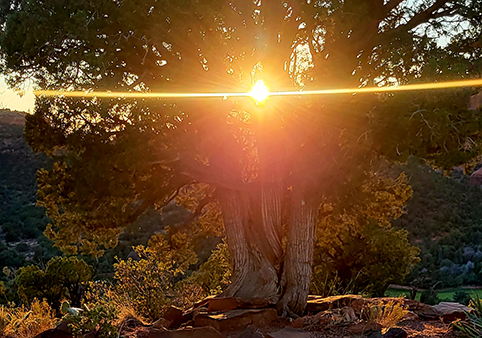The Apache Wars
Before the arrival of European diseases, the Apache were an extremely healthy people, traveling great distances regardless of weather conditions. They could literally "live off the land" hunting game, harvesting berries and cacti as they went, moving through summer heat or freezing cold with little, or no discomfort.
Descending on the Southwest from the north, the Apache were Athabascan bands that were so successful their territory ranged from the Rocky Mountains to the northern plains of the Colorado Plateau, south to Mexico. They lived in permanent villages, hunting, farming, and foraging in the surrounding areas. They also conducted extensive buffalo hunts, grew maize, and harvested lots of mescal. There is mounting evidence that the Apache displaced the Sinagua and Hohokam who lived in the Verde Valley.
Women were held in high regard—protected, cherished and respected. Girls were raised to be proficient with bows and arrows, slings, and spears. Trained as well for horseback riding and combat, there was little in their upbringing that differed from the boys. In times of war women were allowed to go on the warpath with their men.
When the 1800’s began the Apache maintained amicable relations with the pioneers, trappers and prospectors who entered the region. In the 1830’s however the Spanish instituted an ancient scalp-bounty system - $100 for a male scalp and $50 for a female to help clear the Apache out of valuable land.
By the 1850’s the subsistence patterns of hunting and gathering were being encroached upon by settlers and the Indians began to retaliate by stealing crops. At this point the Apache in the Verde Valley (the Tonto Apache) were living side by side with the Yavapai.
By 1860, open raiding was occurring and Chiricahua Apache leader Cochise was widely known as a shrewd strategist and fearless warrior. When rancher John Ward’s son went missing, Cochise’s band was brought in for questioning. Cochise explained that he had nothing to do with the boy but was arrested anyway. After cutting through the back of the tent with his knife he escaped, but his men did not. Cochise took his own captives and tried to negotiate the release of his men, but after several failed negotiations his men were killed. Cochise murdered his hostages and spent the next 20 years on the warpath exacting revenge.
Whenever an Apache was killed, his next of kin was obliged to seek revenge. The Apache god Usen had never mentioned that it was necessary for the Apache to forgive their enemies. In fact, he seemed to encourage revenge. One life was rarely considered enough to avenge the life of an Apache. Cochise once said, “I have killed ten white men for every Indian slain.”
Beginning about 1865, there was a military presence in the Verde Valley. Camp Lincoln began with just a few Infantry volunteers, but soon the 14th U.S. Infantry arrived, and before long it was renamed Camp Verde. Located between Beaver Creek and the Verde River, the 4 officers and 139 soldiers did their best to protect the 172 men, and two women living in the area. Unfortunately, many soldiers died from malaria epidemics.
In 1871 the Camp Verde Indian Reservation was established for Native Americans living in the Verde Valley. Many of the Indians were not content with the conditions and left to continue raiding, consequently, Lieutenant Colonel George Crook as called in to help restore order.
Crooks winter campaign of 1872-1873 broke the back of Indian resistance in central Arizona. His main tactic was to keep the hostiles on the move, wear them out, and exhaust their food supplies. Crook also tried to convince the natives that life on the reservations could be profitable if they grew extra food that they could sell to the settlers. Unfortunately, ambitious settlers and greedy government officials had the reservation abolished, the land absorbed by white settlers.
In the next few years, 147 Tonto Apache were killed and the Rio Verde Indian Agency in Cottonwood soon housed over 1,000 Yavapai and Apache. In February of 1875, the agency was closed and 1,400 Indians were forced to march for San Carlos. Due to the weather and arduous trail conditions, nearly one hundred died en route.
In 1876, J.J. Thompson became the first permanent settler in Sedona when he built a cabin in Oak Creek Canyon. By 1880 the civilian population of the Verde Valley had shrunk to 122, but there were now 40 women, and 45 children. From this point on Fort Verde saw no further operation activity, although some of its troops served in the south during the Geronimo campaign.
In 1885 Geronimo left San Carlos and went on the warpath, riding with 35 warriors, eight boys, and 100 women and children, thereby beginning the last campaign against the Apaches. Although he was wounded many times, his mastery of guerrilla warfare got him through, losing only six men, two boys, a woman, and a child. Before surrendering, his band killed 75 civilians, 12 Indians from other tribes, two officers, eight soldiers, and more than 100 Mexicans.
Geronimo could never understand the contradictory nature of the white man. The whites could kill, steal, and seize Apache lands at will, but then be horrified when the Apache responded with like actions.
Continued encroachment by the Spanish in Apache territory, the Comanche, Mexican domination, and American occupation of Apache ancestral grounds all kept the Apache down but it was the use of Apache from other tribes as scouts that was the final blow. When Geronimo surrendered to Crook he said he always felt he could fight indefinitely, but once the Gray Fox (Crook) arrived, guided by his own people, he knew that he must either make terms or die fighting. When the Apache wars ended seven of the Apache guides that served under Crook (U.S. Indian Scouts, Company B) were awarded the Congressional Medal of Honor by the President of the United States.
Crook had promised Geronimo that after a short absence, he would be allowed to return home; the government had other plans. After several years in Florida, Geronimo was sent to Oklahoma where he remained until he died. When Geronimo was sent off, the seven Indian Scouts who had received the Congressional Medal of Honor were sent with him; they also were never allowed to return home. When Crook heard about this he resigned his commission.
By 1891 the population of the Verde Valley was over 700 and the last soldier left Camp Verde, transferring it over to civilian care.
NATIVE AMERICAN ART, CULTURE, & ATTRACTIONS
A Day In The West
Western Experience | Family-Friendly | Activities | Native Culture & Tours | Professionally Guided
Pink Jeep Adventures
Family-Friendly | Native Culture & Tours | Professionally Guided












